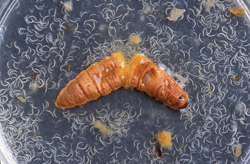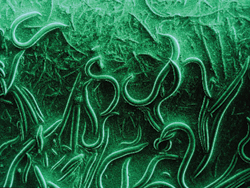
Features
Chemicals
Insects
Beneficial nematodes – Allies in biocontrol
Allies in biocontrol
April 17, 2008 By Karen Dallimore
Have you ever toured a brewery and
stood next to the big brass vats that hold the brew? Now, imagine those
vats full of nematodes.
Have you ever toured a brewery and stood next to the big brass vats that hold the brew? Now, imagine those vats full of nematodes. Beneficial insect-parasitic nematodes, of course – the ones that are being produced commercially for use as biopesticides, one of the biological tools available to those practicing integrated pest
management.
Joe Lara is a product manager for Becker Underwood Incorporated in Iowa, the world’s largest producer of beneficial nematodes. He recently spoke with a group of crop consultants in Guelph, Ontario, outlining some of the details regarding the role and action of
insect-parasitic nematodes as “allies in biocontrol.”
 |
| Inside one of these plump wax moth cadavers are thousands of wiggly nematodes, ready to serve as biocontrols against soil-dwelling crop pests. The cadavers can be placed in orchard or greenhouse soil, and the nematodes will emerge to protect the crops from pests. Photo by Peggy Greb, courtesy of the USDA ARS. |
 |
| Bacterial-feeding nematodes, Operculorhabditissp. LKC10, frozen in liquid nitrogen and magnified about 30 times. Photo by Keith Weller, courtesy of the USDA ARS. |
Nematodes are naturally occurring organisms. They are not an insect but are placed entirely in their own phylum in the animal kingdom. In their vigorously infective juvenile or ‘I.J.’ stage, they attack specific pests by entering natural body openings or by directly penetrating the insect cuticle. Once they gain entry, they move into their reproductive stage and quickly kill the host pest through the release of toxic bacteria.
The dead host then becomes a nematode nursery, nurturing a new batch of infective juvenile nematodes to continue the pest control mission. Nematodes are lousy houseguests – they are so good at destroying their hosts that eventually there are no more pests to infect. At that point, they no longer have a place to live and they will disappear as well.
Early work on bioapplication of nematodes started in the mid-part of the last century, but it is only in the last 10 to 15 years that the product has become available on a commercial scale. Originally, scientists attempted to grow nematodes in live hosts – ‘in vivo’ – but this posed a range of challenges, such as when to harvest the nematodes for shipment and how to hold them at the optimal stage of development for activity.
Under a patented process, Becker Underwood ferments nematodes ‘in vitro.’ In controlled conditions resembling a pharmaceutical laboratory, the production process travels through huge stainless steel fermenting vats that scale up in size from 5,000 litres to 20,000 litres. The end product – the infective juvenile nematodes – is made available as water-miscible powders or gels, convenient for spray application, and shipped in containers across the United States, Europe and Canada.
While smart pest management tactics include choosing the right cultivars as well as weekly detection and monitoring, unfortunately chemicals are often the default mode for pest control. “We are quick to pull the trigger,” says Lara, “but in doing so, we set ourselves up for resistance problems as we lose the efficacy of our current products.
“We ultimately pay the price.”
Integrated pest management is a complex matrix of systems, methods and tools that allows growers to avoid or delay pest resistance, explained Lara. Nematodes have opportunities where chemical alternatives are limited, such as around sensitive habitats or near water bodies where runoff may be a concern. The cost is competitive, at par with certain chemicals, states Lara, but the product does require a little more TLC which carries some extra costs. As with any biological material, they have to be handled carefully, which means that Lara spends a great deal of time educating field consultants regarding their use to achieve optimal results.
It takes a while for the nematode to get in there to do its job, usually requiring about 24 to 72 hours to kill their host. Like all good workers, they work best when you keep them happy. They don’t like direct sunlight, so it is best to apply early or late in the day or drop the drapes for greenhouse growers. They are also happiest in lower temperatures and a damp environment – if you can pre-wet the foliage or pre-irrigate the site, you will get the best results.
One of the major benefits of this natural technology is there are no re-entry issues, an important consideration when you have to get workers back on-site. While nematodes do not necessarily offer 100 per cent control, they do offer fairly rapid knockdown that appears to be equivalent to chemical results.
Different nematode species are carefully identified and formulated to target a range of economically important pests such as western flower thrips, fungus gnats or sciarids in horticultural crops and mushrooms, slugs, vine weevils, cranberry girdlers, and mole crickets in turf.
With the development of any new nematode species to be released on the market, Lara admits there are concerns about shipping nematodes into areas in which they may become an invasive species. “The burden of proof is on us,” he says, to prove there is an indigenous species already present in the area where the nematodes are to be used or the authorities will not let them in.
Becker Underwood has introduced a new product in the U.K. that will target leaf miners in tomatoes, and there is a great deal of interest from the turf and golf course industries for the use of nematodes to control the European chafer. There is also ongoing research into the control of oriental fruit moths, Japanese beetles, chinch bugs, and turf grubs.
Print this page